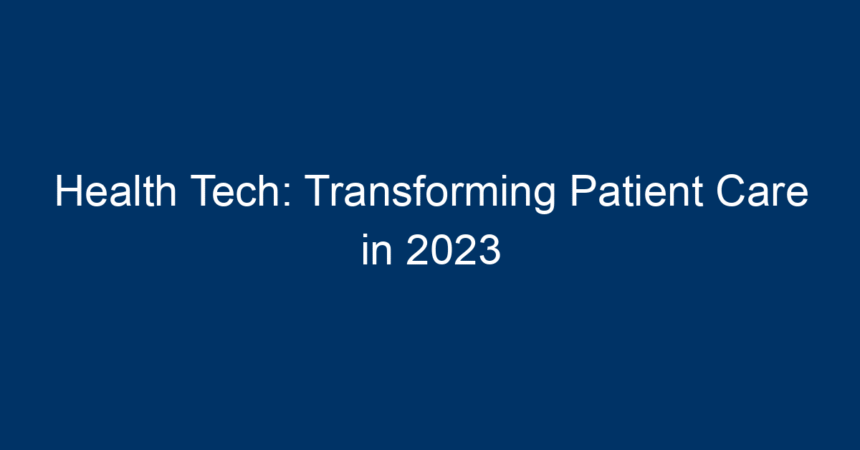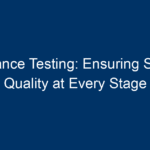The landscape of healthcare is undergoing a seismic shift, primarily fueled by advances in technology. The term "health tech" encompasses a broad spectrum of innovations that enhance patient care, streamline operations, and promote better outcomes. As we dive into 2023, it’s clear that health tech is not just a trend; it’s an essential component of modern healthcare delivery. In this article, we’ll explore how health tech is transforming patient care, the key technologies driving this change, and actionable insights for both healthcare providers and patients.
Understanding Health Tech
Health tech refers to the use of technology in healthcare settings to improve the management of medical processes, information, and communication. This includes everything from telemedicine and electronic health records (EHR) to wearable devices and artificial intelligence (AI). The aim of health tech is to enhance the efficiency, effectiveness, and quality of healthcare services while ensuring patient satisfaction.
The Rise of Telemedicine
One of the most significant developments in health tech in recent years has been the rise of telemedicine. The COVID-19 pandemic accelerated its adoption, with patients seeking remote consultations. Telemedicine allows medical professionals to assess and treat patients without the need for in-person visits, thereby reducing wait times and increasing accessibility.
In 2023, telemedicine continues to evolve. Innovations include:
- Video Consultations: Platforms now offer high-quality video conferencing, enabling doctors to interact with patients in real time.
- Remote Monitoring: Devices can track vital statistics, such as heart rate and blood sugar levels, sending alerts directly to healthcare providers.
- Integrated Apps: Many telemedicine platforms now feature integrated apps that allow for appointment scheduling, medication reminders, and health tracking.
Artificial Intelligence: The New Health Assistant
Artificial Intelligence (AI) is becoming an invaluable tool in patient care. By analyzing vast amounts of data, AI provides insights that enhance diagnosis and treatment options. Here are a few ways AI is being used in 2023:
- Predictive Analytics: AI algorithms can predict patient outcomes based on historical data, helping healthcare providers make informed decisions.
- Natural Language Processing: AI can analyze clinical notes and documentation, ensuring that crucial information is accurately captured and acted upon.
- Personalized Treatment Plans: By considering individual patient data, AI can suggest tailored treatment plans, enhancing the effectiveness of care.
Wearable Technology and Remote Monitoring
Wearable technology is no longer a luxury; in 2023, it is a healthcare necessity. Devices like smartwatches and fitness trackers are not only tracking physical activity but also monitoring vital signs and chronic conditions. Here’s how they are making an impact:
- Continuous Monitoring: Wearables can monitor heart rates, blood pressure, and even oxygen levels continuously, providing real-time data to both patients and healthcare providers.
- Chronic Disease Management: For conditions like diabetes, wearables can help in tracking blood glucose levels, leading to timely interventions.
- Enhanced Patient Engagement: By allowing patients to take charge of their health, wearables empower them to make informed choices and foster a proactive approach to their well-being.
Electronic Health Records (EHR) and Interoperability
The transformation of patient care also hinges on the effective use of Electronic Health Records (EHR). In 2023, EHR systems are more robust and user-friendly, focusing on interoperability:
- Seamless Data Sharing: Interoperable EHR systems allow different healthcare providers and institutions to access patient records efficiently, ensuring continuity of care.
- Reduced Administrative Burden: Modern EHR systems streamline administrative tasks, allowing healthcare providers to focus on patient care.
- Improved Care Coordination: When different specialists have access to the same patient data, it decreases the chances of duplicate testing and conflicting treatments.
Digital Health Applications
Mobile health applications (mHealth) are gaining traction in 2023, providing patients with easy access to their healthcare needs:
- Patient Portals: These applications enable patients to view lab results, schedule appointments, and communicate with their healthcare providers conveniently.
- Medication Management: Apps that provide reminders and track medication adherence are essential for chronic disease management.
- Mental Health Support: Digital health apps focused on mental wellness offer therapy, mindfulness exercises, and community support, making mental health care more accessible.
The Challenges Facing Health Tech Adoption
While health tech offers numerous benefits, it comes with challenges that must be addressed for effective implementation. Here are some critical hurdles:
Data Privacy and Security
With vast amounts of sensitive patient data being collected and analyzed, ensuring data privacy and security is paramount. Healthcare providers must comply with regulations like HIPAA in the U.S. to safeguard patient information.
Integration with Existing Systems
Integrating new technologies with legacy systems can be challenging. Healthcare organizations must invest in training and infrastructure to ensure smooth transitions.
Accessibility and Equity
Not all patients have equal access to health tech. Factors like socioeconomic status, geographic location, and technological literacy can hinder some populations from benefiting from innovations.
Actionable Insights for Healthcare Providers
To thrive in the evolving landscape of health tech, healthcare providers can consider the following strategies:
-
Invest in Training: Provide comprehensive training for staff on using new technologies effectively.
-
Enhance Cybersecurity Measures: Regularly update security protocols to protect patient data and maintain trust.
-
Engage Patients: Encourage patients to utilize health tech tools by demonstrating their benefits and providing support.
-
Monitor Patient Outcomes: Utilize analytics to assess how health tech impacts patient outcomes and adjust strategies accordingly.
- Promote Interoperability: Advocate for systems that facilitate easy sharing of patient information across different platforms.
Conclusion
Health tech is revolutionizing patient care in 2023, offering innovative solutions that enhance diagnosis, treatment, and engagement. By embracing these advancements, healthcare providers can improve outcomes and patient experiences. However, navigating the challenges of data security, integration, and accessibility is crucial for the sustainable success of health tech initiatives. For patients, staying informed and engaged with their health tech tools empowers them in their healthcare journey. As we move further into this digital age, the synergy between technology and healthcare will only grow, shaping a healthier future for everyone.




